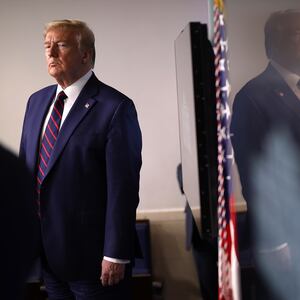As the United States grapples with a rampaging communicable disease that will needlessly take the lives of more Americans than most of the nation’s wars, we are also confronting a president who has rendered our federal government utterly incapable of protecting its nation’s citizens and who has left it to the nation’s governors to desperately compete among themselves for lifesaving medical equipment.
In the vacuum created by a hapless national government, it will fall almost entirely upon the leaders of the states to effectively cooperate in an effort to minimize the grievous cost in human lives our nation will pay.
We are facing an unprecedented test of our federal system, one that will require states to resist fear and mistrust by working together to minimize the virus’ toll, and to do so while Trump—who has fanned the flames of division in the midst of the pandemic—continues to encourage Americans to blame one other, so as to distract them from blaming him.
This week, the president’s scientific advisers have described New York and New Jersey as charnel houses, where tens of thousands will die, even in the best case. For his part, Trump has repeatedly suggested that the state he grew up in bears much of the blame for its own dark fate, purportedly because New York “got off to a very late start” in responding to the pandemic. On Tuesday, Trump asserted that New York Governor Andrew Cuomo “shouldn’t be complaining” that New Yorkers are about to die for a lack of lifesaving ventilators, because Cuomo should have gotten “going sooner.”
The truth, of course, is that Trump and his government ignored repeated warnings from national security and scientific advisers, and deliberately discouraged COVID-19 testing at the crucial point at which the silently growing infection in New York could have been identified and minimized. Indeed, it is only because scientists in Washington State defied CDC instructions by testing samples of flu patients in the Seattle area in February that the scope of the infection there was identified relatively early.
Trump’s gaslighting effort to deflect blame for his own catastrophic failures upon the victims now threatens to impair the nation’s remaining chances of limiting the vast human cost of the pandemic.
As Cuomo, and public health experts, have explained, meeting the goal of effectively treating as many gravely ill Americans as possible will depend on the ability of states to work together. This will require the coordinated sharing of a limited amount of both lifesaving medical equipment and medical professionals, as well as effectively coordinating social distancing measures (particularly between neighboring states), as the virus charts a deadly path through the country over the coming weeks and months.
While the New York region will begin to hit an apex in the number of its critical COVID-19 patients in the coming weeks, that will only be the start of a “rolling wave across the country,” as other states and regions reach their (hopefully) lower peak caseloads during later weeks.
Accordingly, as Cuomo has explained, the best course is to move the limited available human and other resources from place to place, with the movement of the pandemic: according to Cuomo, if “we were smart as a nation,” the health care system would focus its resources on each region facing its period of greatest need; by pursuing this strategy, health care professionals could “get the training, get the experience, and then… go help the next place.” Similarly, the nation could marshal its gravely limited supply of lifesaving medical equipment, most importantly ventilators, by likewise transporting them from place to place, along with the movement of the disease.
The problem is that the federal government, which America has come to expect to take the lead in such times of national challenge, is not directing, or even effectively suggesting, such logistical coordination among the states.
The president has resolutely refused to take control of the supply chain for lifesaving ventilators and other medical equipment, as he is squarely empowered to do by the Defense Production Act. Moreover, as Trump acknowledged on Thursday, he has forced the states to become direct competitors, inducing them to bid against one another in what amount to eBay-like auctions for the same desperately needed ventilators and masks, sometimes only to find that they are all outbid by the federal government or even foreign purchasers.
At the same time, Trump has encouraged Americans to fear one another, just as he has long demonized undocumented immigrants. Last Saturday, Trump paused amidst the din of a waiting helicopter, to offhandedly declare, “Some people would like to see New York quarantined because it’s a hot spot—New York, New Jersey, one or two other places, certain parts of Connecticut, quarantined.” Cuomo responded by stating that such an action would constitute “a declaration of war on states,” and Trump was compelled to discard the proposal.
It later came to light that Trump didn’t get the idea to impose a quarantine on New York from health-care professionals, but rather from one of his favorite governors, Florida’s Ron DeSantis, who famously aired a campaign ad in which he exhorted his young daughter to “build the wall,” while she played with toy blocks.
In the face of the predictable increases in coronavirus infections and deaths in Florida (totaling over 9,000 cases, and about 144 deaths, as of Thursday), DeSantis dithered on taking necessary steps to prevent the transmission of the virus within Florida (he kept the beaches open during Spring Break and only decided to issue a statewide stay-at-home order on Wednesday, and even then excluded houses of worship, where the virus has frequently been spread).
Instead of addressing the growing danger brewing within his state, DeSantis has blamed other Americans for Florida’s plight, asserting that New York and Louisiana are "airdropping in people from the hot zones" into Florida. DeSantis also set up roadblocks to stop and question visitors solely from those two states, and demand that they be subject to quarantines. In fact, only about 4 percent of Florida’s COVID-19 cases involve non-Florida residents.
DeSantis also strongly opposed allowing the docking of cruise ships bearing COVID-19 sufferers from docking in Florida, declaring that the state “cannot afford to have people who are not even Floridians dumped into South Florida using up [the] valuable resources," much of which DeSantis received from the federal government. The governor went so far as to suggest that only Florida residents should be allowed off the vessels, while other passengers should be left to linger, and die, although local officials ultimately decided to allow them to dock.
Cuomo, by contrast, has persisted in offering a model of interstate cooperation by coordinating closely with the governors of neighboring New Jersey and Connecticut to implement and enforce similar stay-at-home regimes.
As Dr. Deborah Birx, a member of Trump's coronavirus task force, acknowledged on Tuesday, the nation cannot hope to stay within the “best case,” which has since likely moved above the initial range of between 100,000 and 240,000 deaths, unless the entire nation implements similarly rigorous social distancing regimes. Once again, coordination among the states, rather than suspicion and blame gaming, is the key to blunting the impact of the pandemic.
This nation has not had a challenge like this in decades, and it remains to be seen whether we will be able to meet the test without effective federal leadership. Will states be able to effectively share resources–and overcome the mistrust and divisions Trump has assiduously fostered–based upon a recognition of their mutual interests? The fate of many Americans may turn upon the answer to that question.







